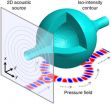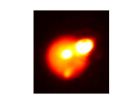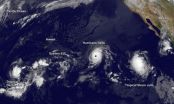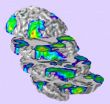(Press-News.org) There's a new wave of sound on the horizon carrying with it a broad scope of tantalizing potential applications, including advanced ultrasonic imaging and therapy, acoustic cloaking, and levitation and particle manipulation. Researchers with the U.S. Department of Energy (DOE)'s Lawrence Berkeley National Laboratory (Berkeley Lab) have developed a technique for generating acoustic bottles in open air that can bend the paths of sound waves along prescribed convex trajectories.
Sound waves move much like light waves. They travel on a straight path but this path - through reflection, diffraction or refraction - can be bent. This is the basis for ultrasound medical imaging and non-destructive testing of materials. An intense search has been underway in recent years to develop techniques that can bend the paths of sound waves along a curved trajectory so as to meet the more stringent demands of super high-resolution imaging, acoustic cloaking and other exotic applications. Artificial nanoconstructs known as "metamaterials" have been engineered that can bend sound waves sufficiently but the nature of these materials places limits on their applications, especially for biological purposes.
"We need to find ways to bend acoustic wave fields without depending on the use of a highly engineered medium," says Xiang Zhang, director of Berkeley Lab's Materials Sciences Division. "With our bottle beam technique, we can design and synthesize acoustic bottles that are capable of directing sound waves along paths of desired curvature through homogeneous space without the need of metamaterials or any other highly engineered medium."
Zhang, who also holds the Ernest S. Kuh Endowed Chair Professor at the University of California (UC) Berkeley, directs the National Science Foundation's Nano-scale Science and Engineering Center, and is a member of the Kavli Energy NanoSciences Institute (ENSI) at Berkeley. He and his group have gained international acclaim for research involving the manipulation of light and sound that has yielded some extraordinary results – an invisibility cloaking device, a plasmonic Airy beam that curves light, the world's first acoustic hyperlens, a four-dimensional crystal that will keep perfect time forever, and much more.
In this latest project, three members of Zhang's research group, Peng Zhang, Tongcang Li and Jie Zhu, created an acoustic "bottle" that features a three-dimensional curved shell, in which a wall of high acoustic pressure surrounds a null pressure region in the middle. Sound waves forming the bottle are concentrated into a beam that travels through the high pressure wall of its curved shell. The sound waves are generated by an array of loud speakers, 1.5 centimeters in diameter and spaces 2.5 centimeters apart, operating at a frequency of 10 kilo Hertz (kHz) and can be launched along a designated trajectory by precisely adjusting the phase profile of the speaker array.
"Since the principle of adjusted phased arrays is well-established and now being used in ultrasound imaging, we can directly apply our acoustic bottle beam technique to current acoustic systems," says Peng Zhang, lead author of a paper in Nature Communications that described this work. (See below for details). "Our technique offers a new degree of freedom for controlling the flow of acoustic energy at will."
Because the high pressure wall of the acoustic bottle exerts a pulling force, there are no sound waves passing through the null pressure interior of the bottle and the bottle can be used for acoustic trapping. Furthermore, the bottle beam is not influenced by any obstacle placed inside the bottle and can even restore itself when an obstacle blocks its path, as the researcher demonstrated with a steel rod.
"Our acoustic bottle beams open new avenues to applications in which there is a need to access hard-to-reach objects hidden behind obstacles, such as acoustic imaging and therapeutic ultrasound through inhomogeneous media," co-author Li says. "We can also use an acoustic bottle as a cloaking device, re-routing sound waves around an object and then recovering them in their original form, making the object invisible to sonar detection."
Acoustic bottle beams might also serve another application that ranks among the hottest in the high-tech community these days – acoustic levitation, in which sound waves are used to lift and manipulate millimeter-sized objects, including particles, microorganisms and droplets of water. A recent study reporting the use of standing sound waves for 3D graphic printing was hailed as a major breakthrough.
"Our acoustic bottle beams can do the same thing but offer better stability, true 3D graphics, and more freedom of motion as our beam can propagate along a curved path," co-author Zu says. "We can also levitate much larger 3D objects than can be lifted and manipulated with other acoustic levitation techniques."
Sui Yang, another co-author of the Nature Communications paper and member of Zhang's research group, notes that the trapping capability for objects larger than the half-wavelength offered by acoustic bottle beams may also add important new tools for material-related studies.
"These giant acoustic traps could lead to new technologies and devices for a variety of applications in chemistry, materials, as well as biosciences," he says. "For example, by creating this three-dimensional bottle-like acoustic trap, we could use it as a micro-chemical reactor and manipulation of biological trafficking devices."
INFORMATION:
The Nature Communications paper describing this research is titled "Generation of acoustic self-bending and bottle beams by phase engineering." Additional co-authors were Xuefeng Zhu, Sui Yang, Yuan Wang and Xiaobo Yin.
This research was supported by the Office of Naval Research's MURI program.
Lawrence Berkeley National Laboratory addresses the world's most urgent scientific challenges by advancing sustainable energy, protecting human health, creating new materials, and revealing the origin and fate of the universe. Founded in 1931, Berkeley Lab's scientific expertise has been recognized with 13 Nobel prizes. The University of California manages Berkeley Lab for the U.S. Department of Energy's Office of Science. For more, visit http://www.lbl.gov.
Berkeley Lab is supported by the Office of Science of the U.S. Department of Energy. The Office of Science is the single largest supporter of basic research in the physical sciences in the United States, and is working to address some of the most pressing challenges of our time. For more information, please visit science.energy.gov.
Bottling up sound waves
Acoustic bottle beams from Berkeley Lab hold promise for imaging, cloaking, levitation and other apps
2014-08-04
ELSE PRESS RELEASES FROM THIS DATE:
Extreme volcanism: Image captures 1 of the brightest volcanoes in the solar system
2014-08-04
During the middle of 2013, Jupiter's moon Io came alive with volcanism. Now, an image from the Gemini Observatory captures what is one of the brightest volcanoes ever seen in our solar system. The image, obtained on August 29, reveals the magnitude of the eruption that was the "grand finale" in a series of eruptions on the distant moon. Io's volcanism is caused by the tidal push-and-pull of massive Jupiter, which heats the satellite's interior – making it our Solar System's most volcanically active known body.
According to University of California Berkeley (UCB) astronomer ...
Earlier intervention for common form of heart attack linked to improved survival
2014-08-04
Changes in the treatment of the most common form of heart attack over the past decade have been associated with higher survival rates for men and women regardless of age, race and ethnicity, according to a UCLA-led analysis.
But the study also suggests that there is room for improvement in how current treatment guidelines are applied among specific patient groups.
The researchers reviewed records for 6.5 million people who were treated for heart attacks between 2002 and 2011. The analysis was among the first and largest national studies to assess the impact of the trend ...
Anorexia fueled by pride about weight loss
2014-08-04
Positive emotions – even those viewed through a distorted lens – may play an exacerbating role in fueling eating disorders like anorexia nervosa, which has a death rate 12 times higher for females between the ages of 15 and 24 than all other causes of death combined, according to a Rutgers study.
In research published in Clinical Psychological Science, Edward Selby, an assistant professor in the Department of Psychology, School of Arts and Sciences, measured over a two week period the emotional states of 118 women between the ages of 18-58 being treated for anorexia nervosa. ...
Satellite view of a hyperactive Eastern and Central Pacific Ocean
2014-08-04
NASA and NOAA satellites have been supplying forecasters with data developing tropical cyclones in the Eastern and Central Pacific Ocean and over the last several days. There have been as many as five tropical systems at the same time. On Monday, August 4, there were three tropical systems stretching from west to east: Tropical Depression Genevieve in the Central Pacific, Hurricane Iselle and Tropical Storm Julio in the Eastern Pacific.
Tropical Depression Genevieve May Strengthen
On August 4, Tropical Depression Genevieve was located about 930 miles (1,495 km) southwest ...
Version 2.0 of Prostate Cancer Risk Calculator now online, complete with emojis
2014-08-04
SAN ANTONIO (August 4, 2014) — A calculator to help men and their doctors assess their risk of prostate cancer, developed at the UT Health Science Center, has had a major upgrade to enhance how men and their physicians better understand a man's risk of prostate cancer.
A description of the update's needs and benefits is described by the Health Science Center authors in a viewpoint published online Monday in the Journal of the American Medical Association.
"The prostate cancer risk calculator has been updated using current risk factors and a better interface; the current ...
Newly discovered juvenile whale shark aggregation in Red Sea
2014-08-04
Whale sharks (Rhincodon typus)—which grow more than 30 feet long—are the largest fish in the world's ocean, but little is known about their movements on a daily basis or over years. A newly discovered juvenile whale shark aggregation off Saudi Arabia is giving researchers a rare glimpse into the lives of these gentle giants.
Scientists from the Woods Hole Oceanographic Institution (WHOI) and colleagues from the King Abdullah University of Science and Technology (KAUST) and Massachusetts Division of Marine Fisheries report on the movements of whale sharks tagged at the ...
Horses communicate with their eyes and mobile ears
2014-08-04
Horses are sensitive to the facial expressions and attention of other horses, including the direction of the eyes and ears. The findings, reported in the Cell Press journal Current Biology on August 4, are a reminder for us humans to look beyond our own limitations and recognize that other species may communicate in ways that we can't, the researchers say. After all, human ears aren't mobile.
"Our study is the first to examine a potential cue to attention that humans do not have: the ears," says Jennifer Wathan of the University of Sussex. "Previous work investigating ...
Declining intelligence in old age linked to visual processing
2014-08-04
Researchers have uncovered one of the basic processes that may help to explain why some people's thinking skills decline in old age. Age-related declines in intelligence are strongly related to declines on a very simple task of visual perception speed, the researchers report in the Cell Press journal Current Biology on August 4.
The evidence comes from experiments in which researchers showed 600 healthy older people very brief flashes of one of two shapes on a screen and measured the time it took each of them to reliably tell one from the other. Participants repeated ...
Prenatal alcohol exposure alters development of brain function
2014-08-04
In the first study of its kind, Prapti Gautam, PhD, and colleagues from The Saban Research Institute of Children's Hospital Los Angeles found that children with fetal alcohol spectrum disorders (FASD) showed weaker brain activation during specific cognitive tasks than their unaffected counterparts. These novel findings suggest a possible neural mechanism for the persistent attention problems seen in individuals with FASD. The results of this study will be published in Cerebral Cortex on August 4.
"Functional magnetic resonance imaging (fMRI) has been used to observe ...
Mid-level scientists most likely to use new research tools, says study in INFORMS journal
2014-08-04
Scientists in the middle of the status hierarchy, not those at the top or the bottom, are the first to work with easy-to-use commercial products. They are also the most prone to imitate their prior collaborators' use of such commercial kits. These are among the findings of a study of scientists-as-customers appearing in Marketing Science, a journal of the Institute for Operations Research and the Management Sciences (INFORMS).
Nonmonotonic Status Effects in New Product Adoption is by Yansong Hu of the University of Warwick and Christophe Van den Bulte of the University ...
LAST 30 PRESS RELEASES:
Numbers in our sights affect how we perceive space
SIMJ announces global collaborative book project in commemoration of its 75th anniversary
Air pollution exposure and birth weight
Obstructive sleep apnea risk and mental health conditions among older adults
How talking slows eye movements behind the wheel
The Ceramic Society of Japan’s Oxoate Ceramics Research Association launches new international book project
Heart-brain connection: international study reveals the role of the vagus nerve in keeping the heart young
Researchers identify Rb1 as a predictive biomarker for a new therapeutic strategy in some breast cancers
Survey reveals ethical gaps slowing AI adoption in pediatric surgery
Stimulant ADHD medications work differently than thought
AI overestimates how smart people are, according to HSE economists
HSE researchers create genome-wide map of quadruplexes
Scientists boost cell "powerhouses" to burn more calories
Automatic label checking: The missing step in making reliable medical AI
Low daily alcohol intake linked to 50% heightened mouth cancer risk in India
American Meteorological Society announces Rick Spinrad as 2026 President-Elect
Biomass-based carbon capture spotlighted in newly released global climate webinar recording
Illuminating invisible nano pollutants: advanced bioimaging tracks the full journey of emerging nanoscale contaminants in living systems
How does age affect recovery from spinal cord injury?
Novel AI tool offers prognosis for patients with head and neck cancer
Fathers’ microplastic exposure tied to their children’s metabolic problems
Research validates laboratory model for studying high-grade serous ovarian cancer
SIR 2026 delivers transformative breakthroughs in minimally invasive medicine to improve patient care
Stem Cell Reports most downloaded papers of 2025 highlight the breadth and impact of stem cell research
Oxford-led study estimates NHS spends around 3% of its primary and secondary care budget on the health impacts of heat and cold in England
A researcher’s long quest leads to a smart composite breakthrough
Urban wild bees act as “microbial sensors” of city health.
New study finds where you live affects recovery after a hip fracture
Forecasting the impact of fully automated vehicle adoption on US road traffic injuries
Alcohol-related hospitalizations from 2016 to 2022
[Press-News.org] Bottling up sound wavesAcoustic bottle beams from Berkeley Lab hold promise for imaging, cloaking, levitation and other apps







